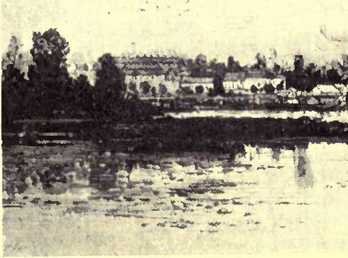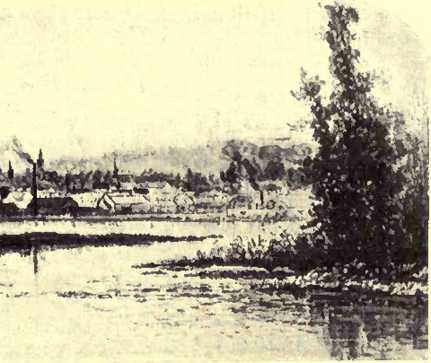|
“Clear the land of evil,
drive the road and bridge the ford.
Make ye sure to each his own That he reap where he hath sown;
By the peace among our peoples let men know we serve the Lord!”
Rudyard Kipling.
LARGE as Simcoe County
now is, it once contained half as many more townships than it does at
present, and was also for a time the mother county of the districts of
Muskoka arid Parry Sound, being responsible for the maintenance of order
and the dispensing of justice throughout that vast wild region. A
quarter of a century ago Simcoe was relieved of this burden, but still
contains sixteen townships. The names of some of these are derived from
Spanish, African, Welsh, and Irish sources, whilst others commemorate
(if tradition speaks truly) two Indian beauties, a great chief and (in
Tiny, Tay, and Floss) the pampered lapdogs of a Governor’s lady.
The name of the county
itself is borrowed from that bestowed on the lovely lake, forming much
of its eastern boundary, by the energetic first Governor of Upper
Canada, in honour of his father, Captain John Simcoe, who was killed
during Wolfe’s siege of Quebec.
The story of Simcoe
County has been written at length, and 1 must gratefully acknowledge my
indebtedness to the labours of its historian, Mr. A. F. Hunter. He
devotes many interesting pages to accounts of the Indian peoples who
occupied the district before the period of immigration from Europe, and
reminds us that it was the scene of Feasts of the Dead when the Hurons
interred in one huge common grave the remains of all their kindred who
had died within ten or twelve years.
In 1615 Champlain made
his way up the Ottawa, Lake Nipissing, and French River to the Georgian
Bay. Then, attended by a friendly band of Indians, he explored the
eastern coast of the bay, passing the spot where Parry Sound now stands,
and turning inland from the site of Penetanguishene to the Huron town of
Otouacha, whither the Recollet missionary, Le Caron, had come before
him. Champlain had promised the Huron chiefs who had visited the
settlements on the St. Lawrcnce his help against the Iroquois; and his
arrival was the signal for the mustering of a great war party, at the
head of which he travelled through the heart of our Province.
The warriors crossed
Lake Simcoe, and paddling on by lake and stream came down the Trent to
its mouth, where Champlain was not much more than two hundred miles from
his starting-point at Montreal. But this was his first sight of Lake
Ontario, over which he passed with his army of painted braves into the
Iroquois country. Unfortunately his fire-breathing arquebus seemed to
have lost its magic, and, lamed by a severe wound, he had to make much
of the long return journey cramped up in a basket on the back of a
stalwart Indian. Obliged to spend the winter in the Huron country, he
continued his explorations, and amongst other journeys made one through
the territory now forming the counties of Bruce and Grey.
The next great chapter
in the history of the county is the tragic story which has been told
with so much brilliancy and pathos by Francis Parkman, of the founding
and destruction of the Jesuit missions to the Hurons. The chief of the
mission towns, in those brief days of sunshine when the courage and
patience of the “Black-robes” had triumphed over the distrust and
stupidity and the superstition of their dusky flocks, was Ste. Marie,
situated on the Wye, a little east of Midland in Simcoe County. With
energy still to spare for other labours the valiant Brebeuf once
penetrated into the country of the ferocious Neutral Nation in the
Niagara Peninsula, but after months of deadly peril was forced to
retreat. Thus narrowly he escaped the crown of martyrdom, only to win it
a few' years later at the hands of the Iroquois, who in one terrible
year swept the Christian villages out of existence and broke forever the
proud spirit of the Huron warriors. In later years another tribe entered
into their ancient hunting-ground, and when, the white men desired to
possess the land they had to purchase it from the Chiefs of the Ojibways.
The fur-traders, of
course, followed the Indians to the wilderness, and early records afford
glimpses of many a picturesque figure doing business with the red men at
strategical points on the great inland waters. Near Matohedash Bay there
settled an English trader, Cowan, who, as a captive in boyhood, had
learned the Indian speech and ways, and relics of his dwelling-place are
still to be seen on the shore. Another trader whose story reads like a
romance established himself at the beginning of the nineteenth century
at the “Narrows” of Lake Simcoe, where Orillia now' stands. This was the
French exile of the Reign of Terror, Quetton St. George, who, having
landed in England on St. George’s Day, had “in gratitude added the
saint’s name to his own.” The Indians, with whom he was popular, called
him “White Hat.” He was a successful trader, and ultimately returned —a
wealthy man—to his native land.
In early years, owing
to its position with regard to the lakes, the great route to the west
lay through Simcoe County. In 1813 a gallant force of 250 men,
consisting

ORILLIA,

The narrows
chiefly of Glengarry
Light Infantry, passed through to reinforce Michillimackinac—and many a
civilian travelled the same road. Amongst these was that “heroic
sailor-soul,” Sir John Franklin, who, twenty years before his last
disastrous voyage, set out from Ponetaiiguishene to explore the Arctic
coasts of Canada.
The first surveys were
made in Simcoe County, a little before the War of 1812, but some of the
work was done carelessly, giving rise in consequence to many disputes
over boundaries. Many towns were laid out on paper, but only two or
three actually came into being, and for years these grew very slowly. In
the pioneer period free grants were given to U. E. Loyalists and their
descendants, to the militia-men of 1812, and to retired British
officers, but other settlers had to obtain their lands by purchase, and
the “land-grabbers” and speculators did their utmost to escape any share
in the cost and labour on opening up the country. Patents for lands were
sometimes issued by those in power in return for votes. In one case it
is said that the number of patents issued before an election exceeded
the whole number of settlers in the township. In fact, election scandals
were as common then as now.
The first election for
Simcoe County (or rather district) was held at Holland Landing, then in
Simcoe, and the only polling place for the huge constituency. The
election lasted six days, and each candidate kept open house at a tavern
for his supporters. On the Monday a settler, an ex-soldier, established
himself at the inn where the adherents of Robinson, the "Family Compact”
candidate, refreshed themselves. There he remained, keeping high revelry
till Saturday, when he went to the poll, attended by a mob of his late
boon companions, and to their intense disgust recorded his vote for
“Cawthra.” He was, indeed, in danger of rough handling, but an audacious
excuse saved him. “Gintlemen,” he shouted,
“I served under
Wellington in the Peninsoolar, an’ moi Giniral larnte me to faste on
moie innimies. Now,” he added, with an oath, " aven’t oi done it?”
In a new country almost
every other problem seems to hang on that of transportation, and for
long years the history of Simcoe County is the history of the efforts of
the people to get roads cut, bridges built, steam-boats put upon the
lakes, railways driven through the country, and now (in this era of
bicycles and automobiles) the old question of usable roads is again to
the fore. Simcoe's first road was the "Nine-mile Portage,” between
Kemperfeldt Bay and Willow Creek, a tributary of the Notcawasaga. This
was in one place so steep that when, in 1813, cannon had to be taken
over it, it was necessary to put ropes round the trees at the wayside to
prevent the loads going too fast. Later, in some districts, “planked
roads" were tried, proving a great boon at first, but soon wearing out.
A feature of the times was the enormous number of taverns, the more
travelled roads, having one to every mile or so. Innkeepers and carters
opposed the building of railways “tooth and nail,’ but in vain.
Simcoe County, which
was destined to have “a woeful experience” of the costliness of the
early railways, can at least claim the honour of having, in the Northern
Railway, the first line "of any extent completed in Ontario.” The engine
which pulled the first train out of Toronto on a bright May morning in
1853 was the first ever built in Canada. It was appropriately named “the
Toronto”—an earlier engine, “the Lady Elgin,” used in construction work,
having been built in New Jersey.
A subject nearly
related to roads and railways is that of the mails, which before 1837
were carried chiefly by men on foot or horseback. In those days it cost
lour-pence-halfpenny to send a letter from Toronto to Barrie, and to
more distant places in proportion. This, of course, kept down the number
of letters. In 1832 the postmaster of Orillia found plenty of space for
the mail of the whole countryside in a birch-bark basket, and during
“the fifties” the good-natured postmaster of Innisfil, by way of saving
the settlers many a long walk, used when going to church on a Sunday to
“crowd" his tall "plug hat" full of letters.
Speaking of churches,
the first Protestant place of worship appears to have been a log-cabin
built about 1S23 in the "Scotch Settlement” (of refugees from Lord
Selkirk’s ill-fated Red River Colony) in West Gwiilimburv. An
interesting old church of Simcoe's pioneer days still stands at Shanty
Bay, a neighbourhood which was once largely settled by half-pay
officers. The edifice is built of mud-bricks. and has been kept in
excellent repair. Within is a memorial tablet to Lucius O'Brien, one of
Canada’s earliest notable artists, and not far distant is the large old
log-house built by his father.
The historian of Simcoe
County dates events before and after the Rebellion of 1837. At that time
there was some disaffection, especially in the southern parts of the
count}’, but the population, on the whole, was eagerly loyal. The men
sprang to arms, leaving only women and children in the settlements. It
is told that the day after the fight at Montgomery’s Tavern six hundred
men of Simcoe, under command of Lieutenant-Colonel Dewson, came marching
down Yonge Street, headed by Highland pipers playing the national
pibroch. With this party were brought in sixty prisoners, tied to a long
pole.
Many of these were
released on parole, but Samuel Lount, who had formerly represented
Simcoe County in the Assembly, was captured after attempting to escape
in an open boat across Lake Erie, and, in spite of many petitions to
Governor Arthur for mercy upon him, was executed in the following April. |
